Leading Change: Zara and Primark - Strategies and Impacts Report
VerifiedAdded on 2021/01/02
|14
|3863
|454
Report
AI Summary
This report examines organizational change and leadership through a comparative analysis of Zara and Primark. It begins with an introduction to organizational change and its impact, followed by a comparison of the two companies' strategic and operational changes, including technological and structural adjustments. The report then evaluates the influence of internal and external drivers of change on leadership, teams, and individual behaviors, alongside measures to mitigate negative impacts. It explores barriers to change and their effect on leadership decision-making, and concludes by applying different leadership approaches to managing change within these organizations. The report uses frameworks like the Burke-Litwin Model to analyze change and offers insights into how organizations can adapt to dynamic environments.

Understanding and
leading change
leading change
Paraphrase This Document
Need a fresh take? Get an instant paraphrase of this document with our AI Paraphraser
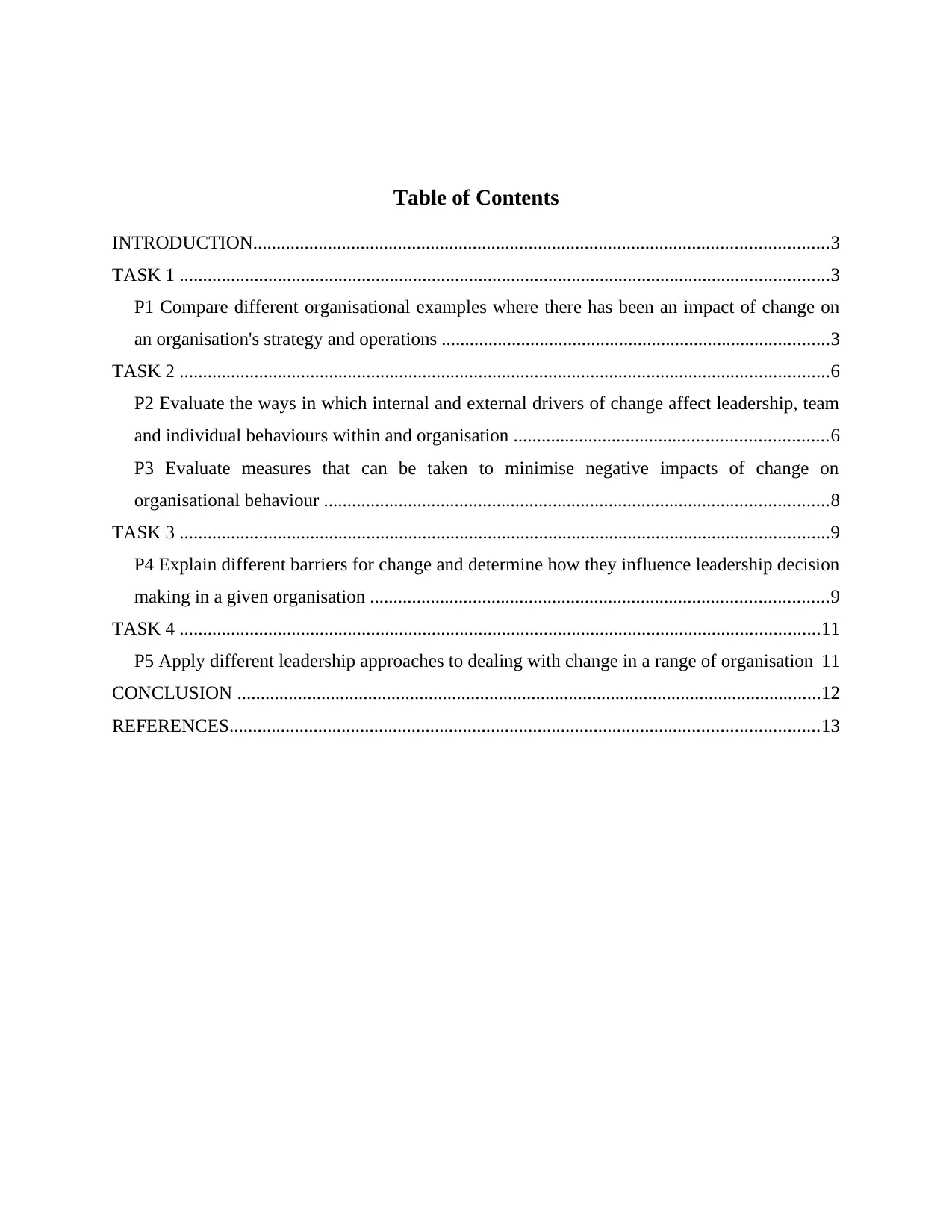
Table of Contents
INTRODUCTION...........................................................................................................................3
TASK 1 ...........................................................................................................................................3
P1 Compare different organisational examples where there has been an impact of change on
an organisation's strategy and operations ...................................................................................3
TASK 2 ...........................................................................................................................................6
P2 Evaluate the ways in which internal and external drivers of change affect leadership, team
and individual behaviours within and organisation ...................................................................6
P3 Evaluate measures that can be taken to minimise negative impacts of change on
organisational behaviour ............................................................................................................8
TASK 3 ...........................................................................................................................................9
P4 Explain different barriers for change and determine how they influence leadership decision
making in a given organisation ..................................................................................................9
TASK 4 .........................................................................................................................................11
P5 Apply different leadership approaches to dealing with change in a range of organisation 11
CONCLUSION .............................................................................................................................12
REFERENCES..............................................................................................................................13
INTRODUCTION...........................................................................................................................3
TASK 1 ...........................................................................................................................................3
P1 Compare different organisational examples where there has been an impact of change on
an organisation's strategy and operations ...................................................................................3
TASK 2 ...........................................................................................................................................6
P2 Evaluate the ways in which internal and external drivers of change affect leadership, team
and individual behaviours within and organisation ...................................................................6
P3 Evaluate measures that can be taken to minimise negative impacts of change on
organisational behaviour ............................................................................................................8
TASK 3 ...........................................................................................................................................9
P4 Explain different barriers for change and determine how they influence leadership decision
making in a given organisation ..................................................................................................9
TASK 4 .........................................................................................................................................11
P5 Apply different leadership approaches to dealing with change in a range of organisation 11
CONCLUSION .............................................................................................................................12
REFERENCES..............................................................................................................................13
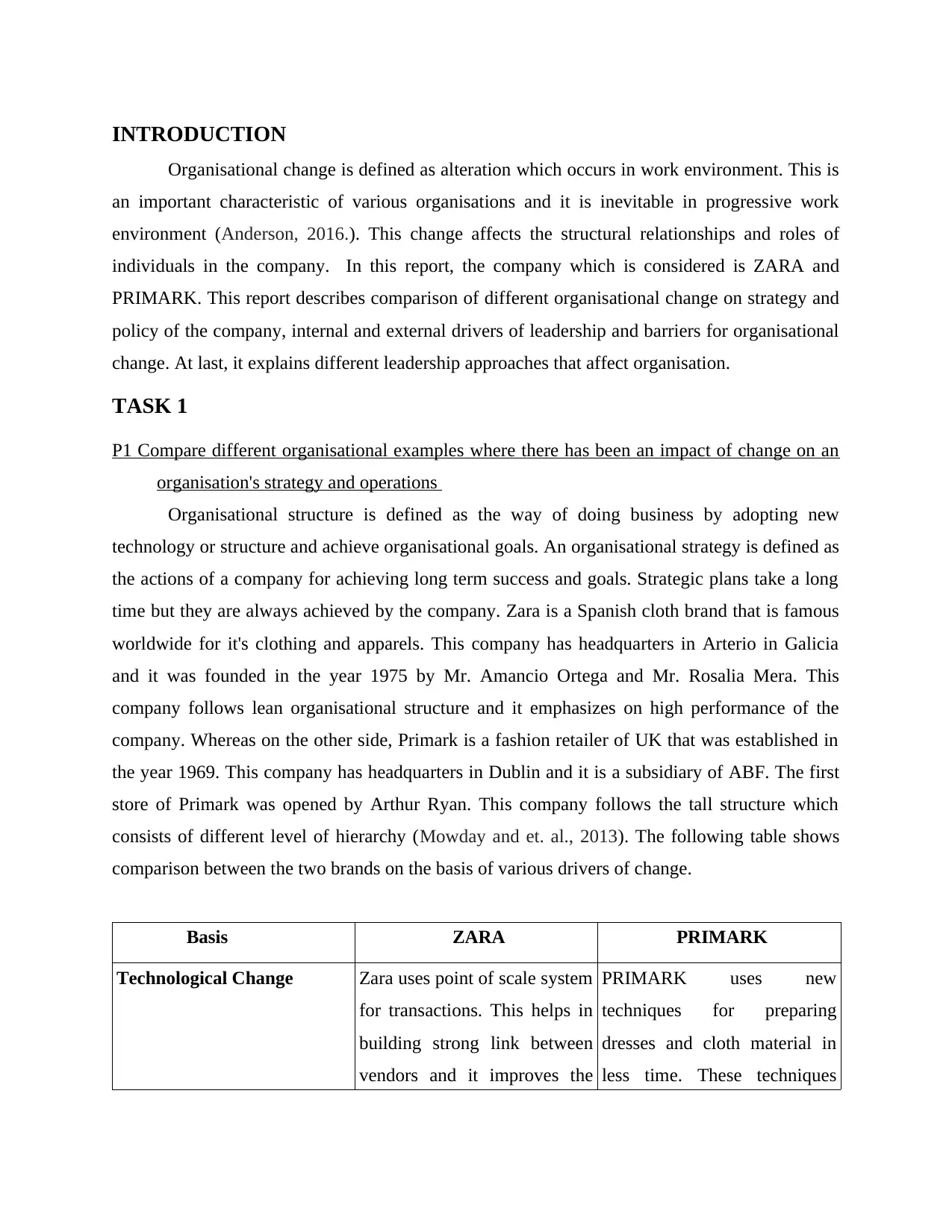
INTRODUCTION
Organisational change is defined as alteration which occurs in work environment. This is
an important characteristic of various organisations and it is inevitable in progressive work
environment (Anderson, 2016.). This change affects the structural relationships and roles of
individuals in the company. In this report, the company which is considered is ZARA and
PRIMARK. This report describes comparison of different organisational change on strategy and
policy of the company, internal and external drivers of leadership and barriers for organisational
change. At last, it explains different leadership approaches that affect organisation.
TASK 1
P1 Compare different organisational examples where there has been an impact of change on an
organisation's strategy and operations
Organisational structure is defined as the way of doing business by adopting new
technology or structure and achieve organisational goals. An organisational strategy is defined as
the actions of a company for achieving long term success and goals. Strategic plans take a long
time but they are always achieved by the company. Zara is a Spanish cloth brand that is famous
worldwide for it's clothing and apparels. This company has headquarters in Arterio in Galicia
and it was founded in the year 1975 by Mr. Amancio Ortega and Mr. Rosalia Mera. This
company follows lean organisational structure and it emphasizes on high performance of the
company. Whereas on the other side, Primark is a fashion retailer of UK that was established in
the year 1969. This company has headquarters in Dublin and it is a subsidiary of ABF. The first
store of Primark was opened by Arthur Ryan. This company follows the tall structure which
consists of different level of hierarchy (Mowday and et. al., 2013). The following table shows
comparison between the two brands on the basis of various drivers of change.
Basis ZARA PRIMARK
Technological Change Zara uses point of scale system
for transactions. This helps in
building strong link between
vendors and it improves the
PRIMARK uses new
techniques for preparing
dresses and cloth material in
less time. These techniques
Organisational change is defined as alteration which occurs in work environment. This is
an important characteristic of various organisations and it is inevitable in progressive work
environment (Anderson, 2016.). This change affects the structural relationships and roles of
individuals in the company. In this report, the company which is considered is ZARA and
PRIMARK. This report describes comparison of different organisational change on strategy and
policy of the company, internal and external drivers of leadership and barriers for organisational
change. At last, it explains different leadership approaches that affect organisation.
TASK 1
P1 Compare different organisational examples where there has been an impact of change on an
organisation's strategy and operations
Organisational structure is defined as the way of doing business by adopting new
technology or structure and achieve organisational goals. An organisational strategy is defined as
the actions of a company for achieving long term success and goals. Strategic plans take a long
time but they are always achieved by the company. Zara is a Spanish cloth brand that is famous
worldwide for it's clothing and apparels. This company has headquarters in Arterio in Galicia
and it was founded in the year 1975 by Mr. Amancio Ortega and Mr. Rosalia Mera. This
company follows lean organisational structure and it emphasizes on high performance of the
company. Whereas on the other side, Primark is a fashion retailer of UK that was established in
the year 1969. This company has headquarters in Dublin and it is a subsidiary of ABF. The first
store of Primark was opened by Arthur Ryan. This company follows the tall structure which
consists of different level of hierarchy (Mowday and et. al., 2013). The following table shows
comparison between the two brands on the basis of various drivers of change.
Basis ZARA PRIMARK
Technological Change Zara uses point of scale system
for transactions. This helps in
building strong link between
vendors and it improves the
PRIMARK uses new
techniques for preparing
dresses and cloth material in
less time. These techniques
⊘ This is a preview!⊘
Do you want full access?
Subscribe today to unlock all pages.

Trusted by 1+ million students worldwide

ordering process. This
company has installed personal
digital assistance for checking
the availability of new designs
on regular basis. ZARA uses
information technology and
human intelligence as hybrid
model for circulating
information through the
organisation effectively.
When information is properly
send from stores to
headquarters then it enables
control on al operations of
company. ZARA deals with
selling of it's fashion clothes
and apparels online for
attracting more number of
customers.
helps to build cloth material
with least defects and these
are of high quality. As using
new technologies in making
clothes will help company in
completing orders in less time.
This helps them to attract more
customers and to remain
successful and sustain in
market for long time. This
company does not sell its
clothes online but then also
this has nor affected sales of
the company. This company
uses new technology and eco-
friendly techniques to operate.
Structural Change The organisational structure
followed by ZARA is vertical
integration and in this
manufactures have to
introduce new products in very
less time. It has gone for
vertical integration with
manufacturers to introduce
new products in no time. The
online website has boosted the
sales especially in Europe.
Control policy has been
It has expanded its business in
US and Bangladesh to improve
its sales and its annual sales
has indeed increased by 17%.
It was the biggest expansion
with the motive to keep the
prices low. Further, it has
constituted “Ethical Trade and
Environmental Sustainability”
team to assess the performance
with the standard. It has 350
stores and plans to open more
company has installed personal
digital assistance for checking
the availability of new designs
on regular basis. ZARA uses
information technology and
human intelligence as hybrid
model for circulating
information through the
organisation effectively.
When information is properly
send from stores to
headquarters then it enables
control on al operations of
company. ZARA deals with
selling of it's fashion clothes
and apparels online for
attracting more number of
customers.
helps to build cloth material
with least defects and these
are of high quality. As using
new technologies in making
clothes will help company in
completing orders in less time.
This helps them to attract more
customers and to remain
successful and sustain in
market for long time. This
company does not sell its
clothes online but then also
this has nor affected sales of
the company. This company
uses new technology and eco-
friendly techniques to operate.
Structural Change The organisational structure
followed by ZARA is vertical
integration and in this
manufactures have to
introduce new products in very
less time. It has gone for
vertical integration with
manufacturers to introduce
new products in no time. The
online website has boosted the
sales especially in Europe.
Control policy has been
It has expanded its business in
US and Bangladesh to improve
its sales and its annual sales
has indeed increased by 17%.
It was the biggest expansion
with the motive to keep the
prices low. Further, it has
constituted “Ethical Trade and
Environmental Sustainability”
team to assess the performance
with the standard. It has 350
stores and plans to open more
Paraphrase This Document
Need a fresh take? Get an instant paraphrase of this document with our AI Paraphraser
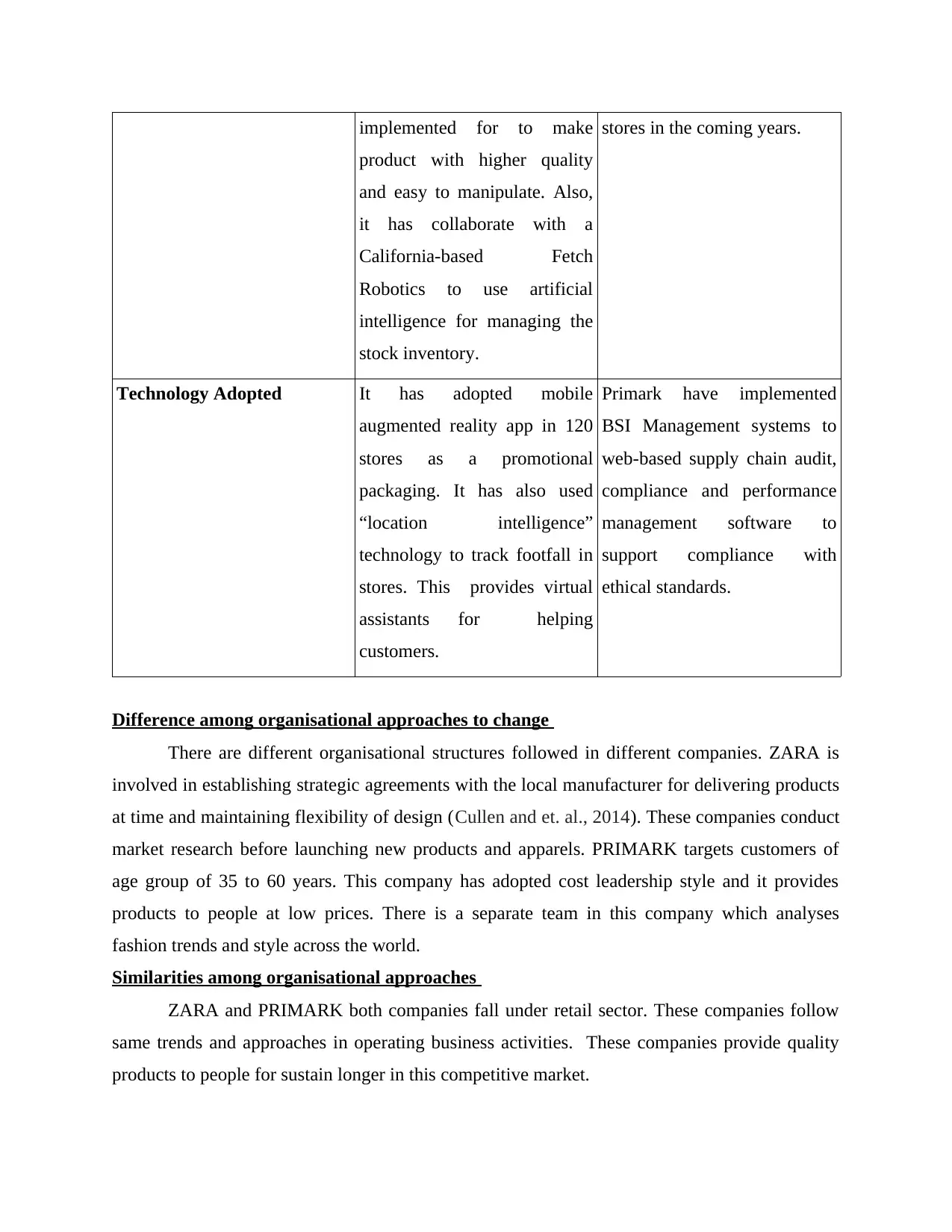
implemented for to make
product with higher quality
and easy to manipulate. Also,
it has collaborate with a
California-based Fetch
Robotics to use artificial
intelligence for managing the
stock inventory.
stores in the coming years.
Technology Adopted It has adopted mobile
augmented reality app in 120
stores as a promotional
packaging. It has also used
“location intelligence”
technology to track footfall in
stores. This provides virtual
assistants for helping
customers.
Primark have implemented
BSI Management systems to
web-based supply chain audit,
compliance and performance
management software to
support compliance with
ethical standards.
Difference among organisational approaches to change
There are different organisational structures followed in different companies. ZARA is
involved in establishing strategic agreements with the local manufacturer for delivering products
at time and maintaining flexibility of design (Cullen and et. al., 2014). These companies conduct
market research before launching new products and apparels. PRIMARK targets customers of
age group of 35 to 60 years. This company has adopted cost leadership style and it provides
products to people at low prices. There is a separate team in this company which analyses
fashion trends and style across the world.
Similarities among organisational approaches
ZARA and PRIMARK both companies fall under retail sector. These companies follow
same trends and approaches in operating business activities. These companies provide quality
products to people for sustain longer in this competitive market.
product with higher quality
and easy to manipulate. Also,
it has collaborate with a
California-based Fetch
Robotics to use artificial
intelligence for managing the
stock inventory.
stores in the coming years.
Technology Adopted It has adopted mobile
augmented reality app in 120
stores as a promotional
packaging. It has also used
“location intelligence”
technology to track footfall in
stores. This provides virtual
assistants for helping
customers.
Primark have implemented
BSI Management systems to
web-based supply chain audit,
compliance and performance
management software to
support compliance with
ethical standards.
Difference among organisational approaches to change
There are different organisational structures followed in different companies. ZARA is
involved in establishing strategic agreements with the local manufacturer for delivering products
at time and maintaining flexibility of design (Cullen and et. al., 2014). These companies conduct
market research before launching new products and apparels. PRIMARK targets customers of
age group of 35 to 60 years. This company has adopted cost leadership style and it provides
products to people at low prices. There is a separate team in this company which analyses
fashion trends and style across the world.
Similarities among organisational approaches
ZARA and PRIMARK both companies fall under retail sector. These companies follow
same trends and approaches in operating business activities. These companies provide quality
products to people for sustain longer in this competitive market.
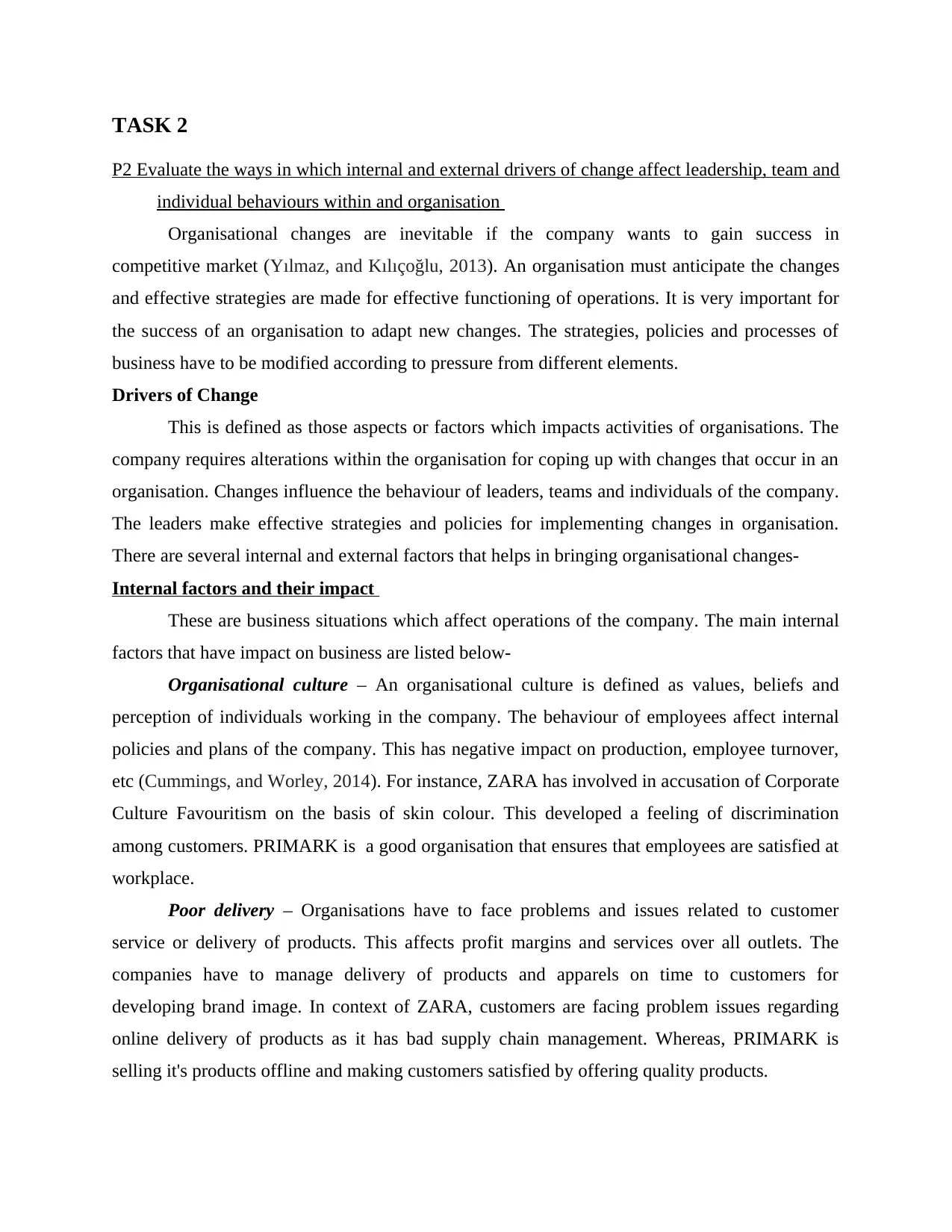
TASK 2
P2 Evaluate the ways in which internal and external drivers of change affect leadership, team and
individual behaviours within and organisation
Organisational changes are inevitable if the company wants to gain success in
competitive market (Yılmaz, and Kılıçoğlu, 2013). An organisation must anticipate the changes
and effective strategies are made for effective functioning of operations. It is very important for
the success of an organisation to adapt new changes. The strategies, policies and processes of
business have to be modified according to pressure from different elements.
Drivers of Change
This is defined as those aspects or factors which impacts activities of organisations. The
company requires alterations within the organisation for coping up with changes that occur in an
organisation. Changes influence the behaviour of leaders, teams and individuals of the company.
The leaders make effective strategies and policies for implementing changes in organisation.
There are several internal and external factors that helps in bringing organisational changes-
Internal factors and their impact
These are business situations which affect operations of the company. The main internal
factors that have impact on business are listed below-
Organisational culture – An organisational culture is defined as values, beliefs and
perception of individuals working in the company. The behaviour of employees affect internal
policies and plans of the company. This has negative impact on production, employee turnover,
etc (Cummings, and Worley, 2014). For instance, ZARA has involved in accusation of Corporate
Culture Favouritism on the basis of skin colour. This developed a feeling of discrimination
among customers. PRIMARK is a good organisation that ensures that employees are satisfied at
workplace.
Poor delivery – Organisations have to face problems and issues related to customer
service or delivery of products. This affects profit margins and services over all outlets. The
companies have to manage delivery of products and apparels on time to customers for
developing brand image. In context of ZARA, customers are facing problem issues regarding
online delivery of products as it has bad supply chain management. Whereas, PRIMARK is
selling it's products offline and making customers satisfied by offering quality products.
P2 Evaluate the ways in which internal and external drivers of change affect leadership, team and
individual behaviours within and organisation
Organisational changes are inevitable if the company wants to gain success in
competitive market (Yılmaz, and Kılıçoğlu, 2013). An organisation must anticipate the changes
and effective strategies are made for effective functioning of operations. It is very important for
the success of an organisation to adapt new changes. The strategies, policies and processes of
business have to be modified according to pressure from different elements.
Drivers of Change
This is defined as those aspects or factors which impacts activities of organisations. The
company requires alterations within the organisation for coping up with changes that occur in an
organisation. Changes influence the behaviour of leaders, teams and individuals of the company.
The leaders make effective strategies and policies for implementing changes in organisation.
There are several internal and external factors that helps in bringing organisational changes-
Internal factors and their impact
These are business situations which affect operations of the company. The main internal
factors that have impact on business are listed below-
Organisational culture – An organisational culture is defined as values, beliefs and
perception of individuals working in the company. The behaviour of employees affect internal
policies and plans of the company. This has negative impact on production, employee turnover,
etc (Cummings, and Worley, 2014). For instance, ZARA has involved in accusation of Corporate
Culture Favouritism on the basis of skin colour. This developed a feeling of discrimination
among customers. PRIMARK is a good organisation that ensures that employees are satisfied at
workplace.
Poor delivery – Organisations have to face problems and issues related to customer
service or delivery of products. This affects profit margins and services over all outlets. The
companies have to manage delivery of products and apparels on time to customers for
developing brand image. In context of ZARA, customers are facing problem issues regarding
online delivery of products as it has bad supply chain management. Whereas, PRIMARK is
selling it's products offline and making customers satisfied by offering quality products.
⊘ This is a preview!⊘
Do you want full access?
Subscribe today to unlock all pages.

Trusted by 1+ million students worldwide
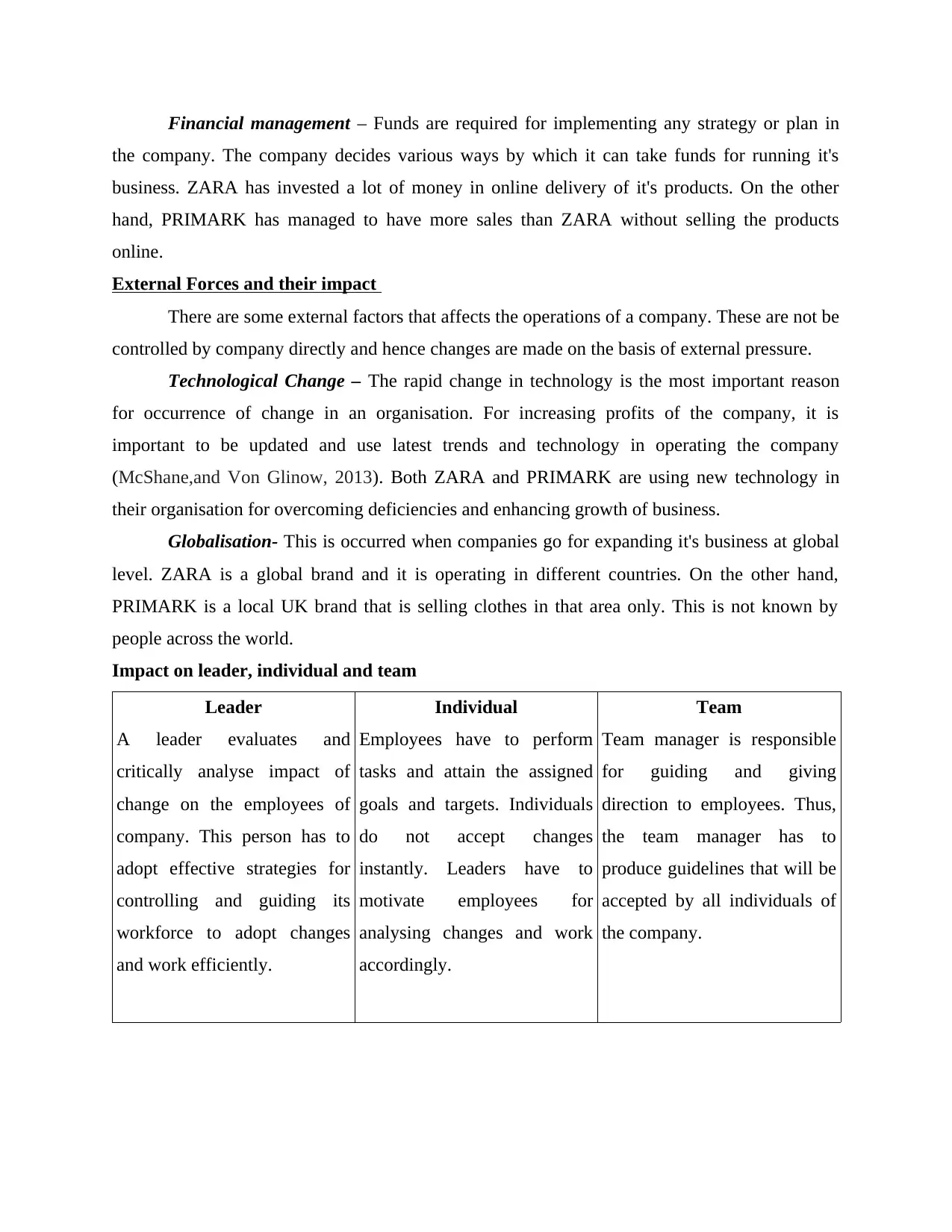
Financial management – Funds are required for implementing any strategy or plan in
the company. The company decides various ways by which it can take funds for running it's
business. ZARA has invested a lot of money in online delivery of it's products. On the other
hand, PRIMARK has managed to have more sales than ZARA without selling the products
online.
External Forces and their impact
There are some external factors that affects the operations of a company. These are not be
controlled by company directly and hence changes are made on the basis of external pressure.
Technological Change – The rapid change in technology is the most important reason
for occurrence of change in an organisation. For increasing profits of the company, it is
important to be updated and use latest trends and technology in operating the company
(McShane,and Von Glinow, 2013). Both ZARA and PRIMARK are using new technology in
their organisation for overcoming deficiencies and enhancing growth of business.
Globalisation- This is occurred when companies go for expanding it's business at global
level. ZARA is a global brand and it is operating in different countries. On the other hand,
PRIMARK is a local UK brand that is selling clothes in that area only. This is not known by
people across the world.
Impact on leader, individual and team
Leader
A leader evaluates and
critically analyse impact of
change on the employees of
company. This person has to
adopt effective strategies for
controlling and guiding its
workforce to adopt changes
and work efficiently.
Individual
Employees have to perform
tasks and attain the assigned
goals and targets. Individuals
do not accept changes
instantly. Leaders have to
motivate employees for
analysing changes and work
accordingly.
Team
Team manager is responsible
for guiding and giving
direction to employees. Thus,
the team manager has to
produce guidelines that will be
accepted by all individuals of
the company.
the company. The company decides various ways by which it can take funds for running it's
business. ZARA has invested a lot of money in online delivery of it's products. On the other
hand, PRIMARK has managed to have more sales than ZARA without selling the products
online.
External Forces and their impact
There are some external factors that affects the operations of a company. These are not be
controlled by company directly and hence changes are made on the basis of external pressure.
Technological Change – The rapid change in technology is the most important reason
for occurrence of change in an organisation. For increasing profits of the company, it is
important to be updated and use latest trends and technology in operating the company
(McShane,and Von Glinow, 2013). Both ZARA and PRIMARK are using new technology in
their organisation for overcoming deficiencies and enhancing growth of business.
Globalisation- This is occurred when companies go for expanding it's business at global
level. ZARA is a global brand and it is operating in different countries. On the other hand,
PRIMARK is a local UK brand that is selling clothes in that area only. This is not known by
people across the world.
Impact on leader, individual and team
Leader
A leader evaluates and
critically analyse impact of
change on the employees of
company. This person has to
adopt effective strategies for
controlling and guiding its
workforce to adopt changes
and work efficiently.
Individual
Employees have to perform
tasks and attain the assigned
goals and targets. Individuals
do not accept changes
instantly. Leaders have to
motivate employees for
analysing changes and work
accordingly.
Team
Team manager is responsible
for guiding and giving
direction to employees. Thus,
the team manager has to
produce guidelines that will be
accepted by all individuals of
the company.
Paraphrase This Document
Need a fresh take? Get an instant paraphrase of this document with our AI Paraphraser
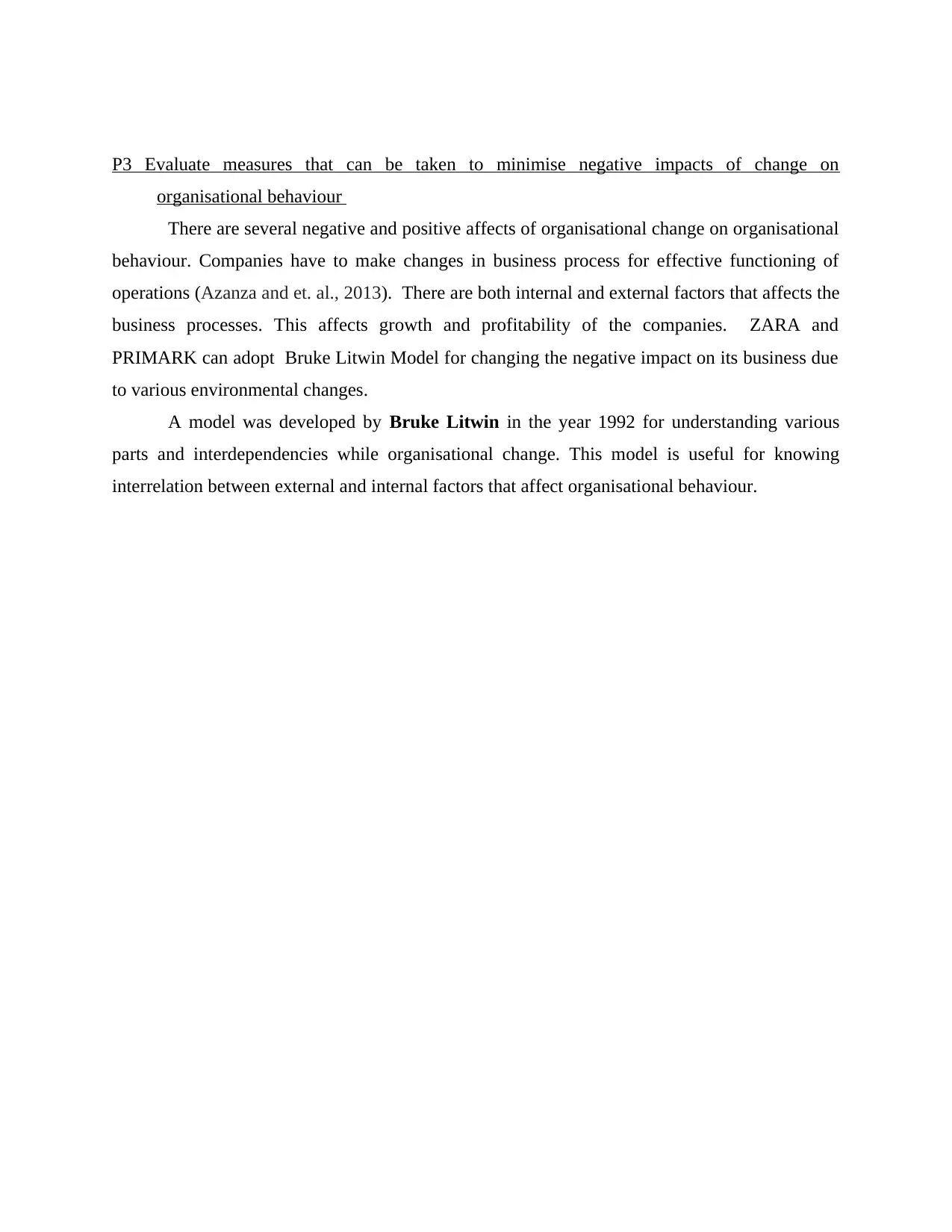
P3 Evaluate measures that can be taken to minimise negative impacts of change on
organisational behaviour
There are several negative and positive affects of organisational change on organisational
behaviour. Companies have to make changes in business process for effective functioning of
operations (Azanza and et. al., 2013). There are both internal and external factors that affects the
business processes. This affects growth and profitability of the companies. ZARA and
PRIMARK can adopt Bruke Litwin Model for changing the negative impact on its business due
to various environmental changes.
A model was developed by Bruke Litwin in the year 1992 for understanding various
parts and interdependencies while organisational change. This model is useful for knowing
interrelation between external and internal factors that affect organisational behaviour.
organisational behaviour
There are several negative and positive affects of organisational change on organisational
behaviour. Companies have to make changes in business process for effective functioning of
operations (Azanza and et. al., 2013). There are both internal and external factors that affects the
business processes. This affects growth and profitability of the companies. ZARA and
PRIMARK can adopt Bruke Litwin Model for changing the negative impact on its business due
to various environmental changes.
A model was developed by Bruke Litwin in the year 1992 for understanding various
parts and interdependencies while organisational change. This model is useful for knowing
interrelation between external and internal factors that affect organisational behaviour.
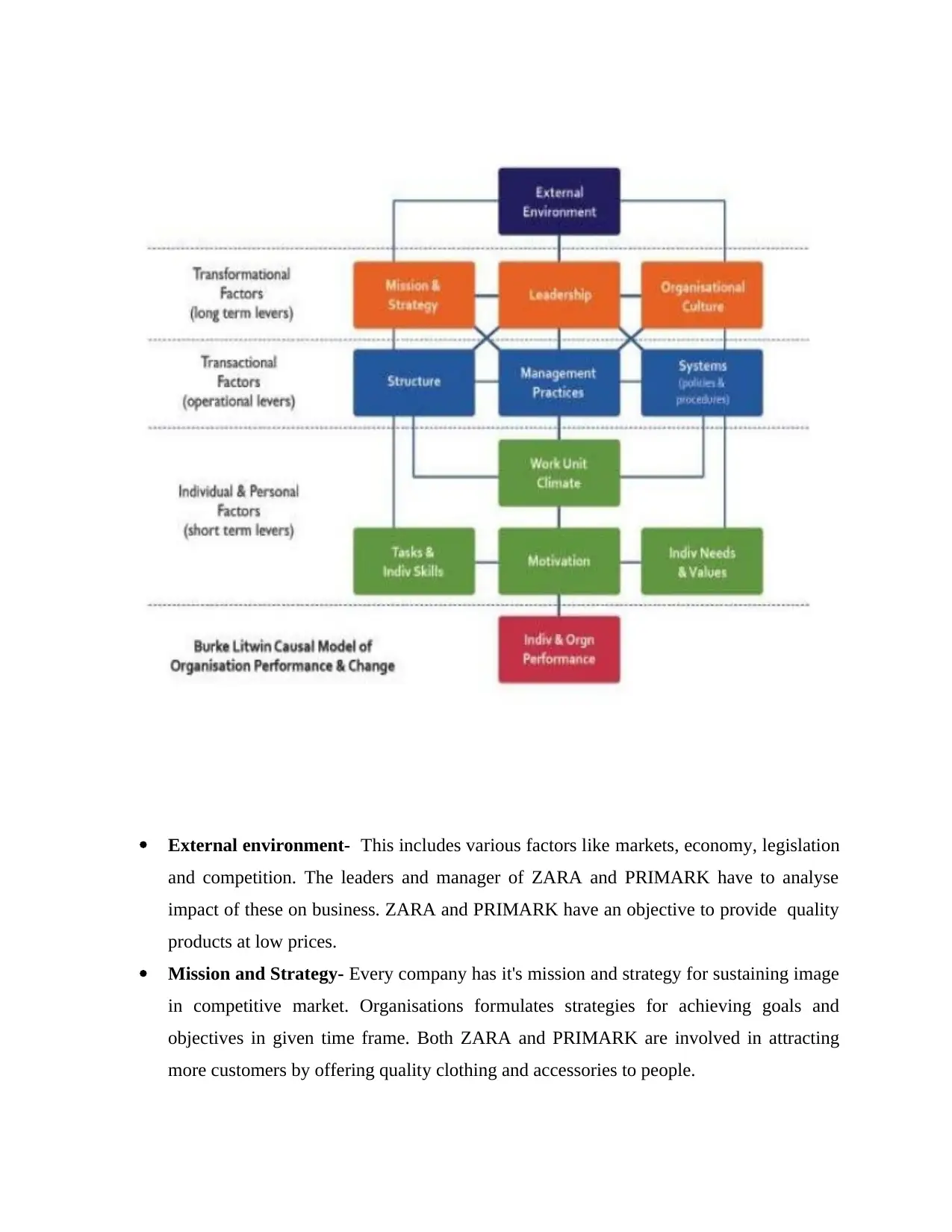
External environment- This includes various factors like markets, economy, legislation
and competition. The leaders and manager of ZARA and PRIMARK have to analyse
impact of these on business. ZARA and PRIMARK have an objective to provide quality
products at low prices.
Mission and Strategy- Every company has it's mission and strategy for sustaining image
in competitive market. Organisations formulates strategies for achieving goals and
objectives in given time frame. Both ZARA and PRIMARK are involved in attracting
more customers by offering quality clothing and accessories to people.
and competition. The leaders and manager of ZARA and PRIMARK have to analyse
impact of these on business. ZARA and PRIMARK have an objective to provide quality
products at low prices.
Mission and Strategy- Every company has it's mission and strategy for sustaining image
in competitive market. Organisations formulates strategies for achieving goals and
objectives in given time frame. Both ZARA and PRIMARK are involved in attracting
more customers by offering quality clothing and accessories to people.
⊘ This is a preview!⊘
Do you want full access?
Subscribe today to unlock all pages.

Trusted by 1+ million students worldwide

Leadership- The Behaviour of manager and leader affects attitude and behaviour of the
employees. Managers and leaders have to motivate its employees to adapt changes and
work effectively. ZARA and PRIMARK must adopt leadership policies for sustaining
longer in business environment.
TASK 3
P4 Explain different barriers for change and determine how they influence leadership decision
making in a given organisation
An American psychologist Kurt Lewis has developed a force field analysis for estimating
the factors which can influence in a particular situation or event. The force field analysis is used
for decision making in planning and implementation of change management programs in the
company. A force filed analysis helps the company to analyse which are the changes that can be
adopted by business and will they help in earning profits and making money. Changes are
inevitable in nature and business needs changes for improving the benefits of the company. This
is a strong method of gaining a comprehensive overview of various forces that acts on potential
organisational change. This includes three stages- unfreeze, change and refreeze.
Barriers of organisational change management
The barriers are defined as obstacles or hurdles that stops a company in operating
business activities. There are different reasons for individual's resistance to organisational
change. This impacts business in a negative manner and this has to be handled properly for
making stable operations (Palmer and et. al., 2016). The main barriers of ZARA in change
management are listed below-
Lack of employee involvement – Employees are scared of change in organisation as they
are habitual of working in same business environment and they are afraid of adapting the new
technologies and techniques. Employees who are not ready to adapt organisational change are a
reason for failure of some organisations. Organisations should overcome the fear of employees
and making them to analyse the importance of change in organisational structure. ZARA
motivates its workforce to adapt new technology and work effectively in achieving goals and
targets of the company.
employees. Managers and leaders have to motivate its employees to adapt changes and
work effectively. ZARA and PRIMARK must adopt leadership policies for sustaining
longer in business environment.
TASK 3
P4 Explain different barriers for change and determine how they influence leadership decision
making in a given organisation
An American psychologist Kurt Lewis has developed a force field analysis for estimating
the factors which can influence in a particular situation or event. The force field analysis is used
for decision making in planning and implementation of change management programs in the
company. A force filed analysis helps the company to analyse which are the changes that can be
adopted by business and will they help in earning profits and making money. Changes are
inevitable in nature and business needs changes for improving the benefits of the company. This
is a strong method of gaining a comprehensive overview of various forces that acts on potential
organisational change. This includes three stages- unfreeze, change and refreeze.
Barriers of organisational change management
The barriers are defined as obstacles or hurdles that stops a company in operating
business activities. There are different reasons for individual's resistance to organisational
change. This impacts business in a negative manner and this has to be handled properly for
making stable operations (Palmer and et. al., 2016). The main barriers of ZARA in change
management are listed below-
Lack of employee involvement – Employees are scared of change in organisation as they
are habitual of working in same business environment and they are afraid of adapting the new
technologies and techniques. Employees who are not ready to adapt organisational change are a
reason for failure of some organisations. Organisations should overcome the fear of employees
and making them to analyse the importance of change in organisational structure. ZARA
motivates its workforce to adapt new technology and work effectively in achieving goals and
targets of the company.
Paraphrase This Document
Need a fresh take? Get an instant paraphrase of this document with our AI Paraphraser

Lack of effective communication – Communication is an essential factor for
implementing different strategies in company. When organisational changes occur, leaders and
managers have to make effective strategies for controlling operations of the company. A good
leader conveys to it's team members that change in organisation is important and it will lead to
growth and development of the company. In context of ZARA, the managers and leaders provide
training and development sessions to employees (Huczynski and et. al., 2013). These trainings
help in making employees understand that changes are essential in organisation for making more
profits.
Organisational complexity – Some organisations develop complex processes and
employees are not able to understand plan and strategy of change in system. When there are
changes in the company, process are made complex and this becomes a big barrier in
organisation's success. For avoiding this situation, ZARA uses skilful approach for managing
organisational complexity.
Unknown current state – Some organisational changes include changes in existing
policies and strategies of the company. It is necessary for companies to evaluate the present
policies and strategies before making new strategies for the company. ZARA develops plans,
policies and strategies for enhancing the efficiency of operations.
Bad culture shift planning – Culture plays an important role in the success of
organisation. Employees must analyse interest of employees and then changes should be made.
This is a barrier as employees wants a positive culture in their workplace. ZARA avoids this
barrier by creating job opportunities according to current structure so that a right candidate is
assigned to do the job.
TASK 4
P5 Apply different leadership approaches to dealing with change in a range of organisation
Leadership is an ability which helps in providing instruction, motivation, direction and
guidance to employees who are works in an organisation. With the help of this skill company
achieve their goals and objectives in an effective manner as well as takes effective decision.
Along with this, leadership aids workers for performing well in an organisation and also
implementing different strategies in company. When organisational changes occur, leaders and
managers have to make effective strategies for controlling operations of the company. A good
leader conveys to it's team members that change in organisation is important and it will lead to
growth and development of the company. In context of ZARA, the managers and leaders provide
training and development sessions to employees (Huczynski and et. al., 2013). These trainings
help in making employees understand that changes are essential in organisation for making more
profits.
Organisational complexity – Some organisations develop complex processes and
employees are not able to understand plan and strategy of change in system. When there are
changes in the company, process are made complex and this becomes a big barrier in
organisation's success. For avoiding this situation, ZARA uses skilful approach for managing
organisational complexity.
Unknown current state – Some organisational changes include changes in existing
policies and strategies of the company. It is necessary for companies to evaluate the present
policies and strategies before making new strategies for the company. ZARA develops plans,
policies and strategies for enhancing the efficiency of operations.
Bad culture shift planning – Culture plays an important role in the success of
organisation. Employees must analyse interest of employees and then changes should be made.
This is a barrier as employees wants a positive culture in their workplace. ZARA avoids this
barrier by creating job opportunities according to current structure so that a right candidate is
assigned to do the job.
TASK 4
P5 Apply different leadership approaches to dealing with change in a range of organisation
Leadership is an ability which helps in providing instruction, motivation, direction and
guidance to employees who are works in an organisation. With the help of this skill company
achieve their goals and objectives in an effective manner as well as takes effective decision.
Along with this, leadership aids workers for performing well in an organisation and also
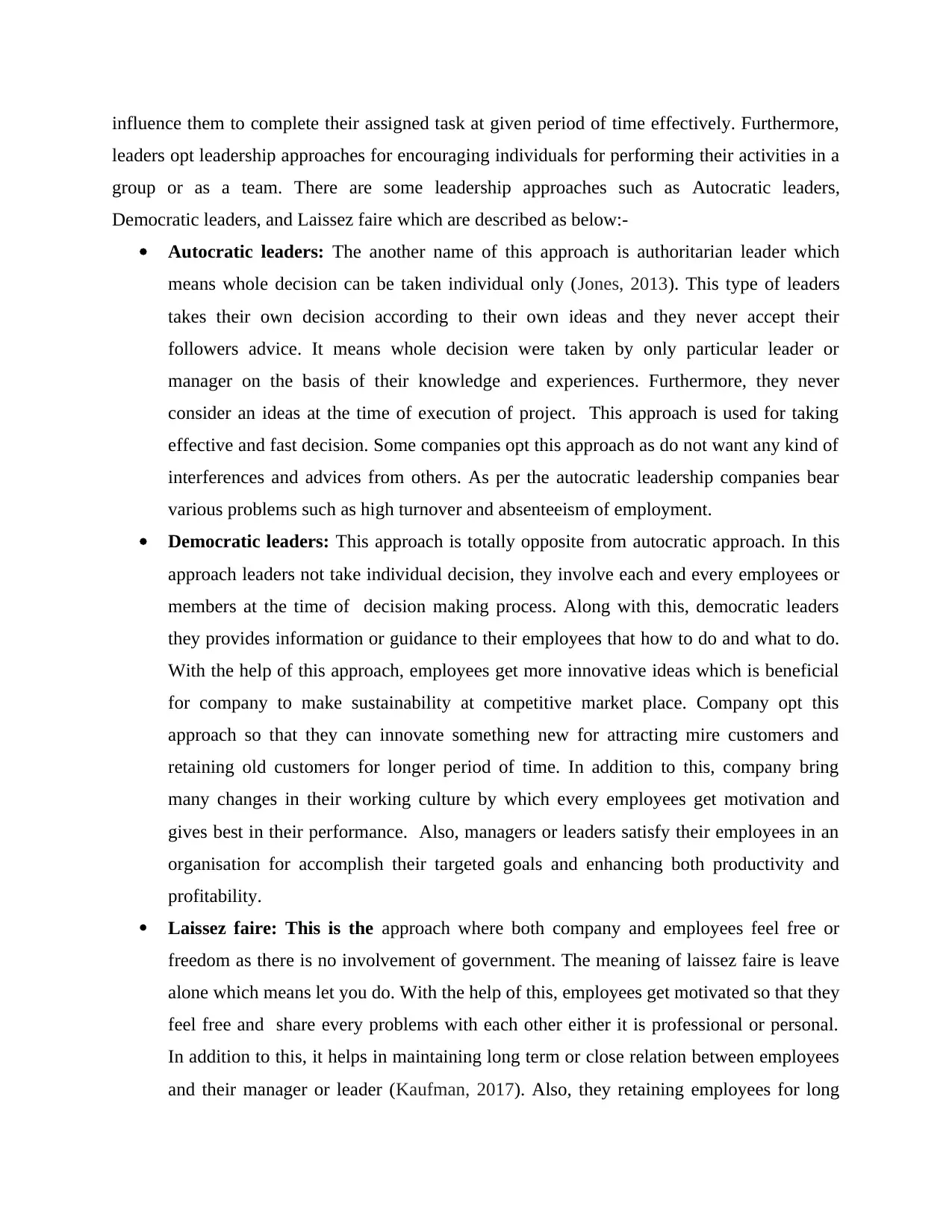
influence them to complete their assigned task at given period of time effectively. Furthermore,
leaders opt leadership approaches for encouraging individuals for performing their activities in a
group or as a team. There are some leadership approaches such as Autocratic leaders,
Democratic leaders, and Laissez faire which are described as below:-
Autocratic leaders: The another name of this approach is authoritarian leader which
means whole decision can be taken individual only (Jones, 2013). This type of leaders
takes their own decision according to their own ideas and they never accept their
followers advice. It means whole decision were taken by only particular leader or
manager on the basis of their knowledge and experiences. Furthermore, they never
consider an ideas at the time of execution of project. This approach is used for taking
effective and fast decision. Some companies opt this approach as do not want any kind of
interferences and advices from others. As per the autocratic leadership companies bear
various problems such as high turnover and absenteeism of employment.
Democratic leaders: This approach is totally opposite from autocratic approach. In this
approach leaders not take individual decision, they involve each and every employees or
members at the time of decision making process. Along with this, democratic leaders
they provides information or guidance to their employees that how to do and what to do.
With the help of this approach, employees get more innovative ideas which is beneficial
for company to make sustainability at competitive market place. Company opt this
approach so that they can innovate something new for attracting mire customers and
retaining old customers for longer period of time. In addition to this, company bring
many changes in their working culture by which every employees get motivation and
gives best in their performance. Also, managers or leaders satisfy their employees in an
organisation for accomplish their targeted goals and enhancing both productivity and
profitability.
Laissez faire: This is the approach where both company and employees feel free or
freedom as there is no involvement of government. The meaning of laissez faire is leave
alone which means let you do. With the help of this, employees get motivated so that they
feel free and share every problems with each other either it is professional or personal.
In addition to this, it helps in maintaining long term or close relation between employees
and their manager or leader (Kaufman, 2017). Also, they retaining employees for long
leaders opt leadership approaches for encouraging individuals for performing their activities in a
group or as a team. There are some leadership approaches such as Autocratic leaders,
Democratic leaders, and Laissez faire which are described as below:-
Autocratic leaders: The another name of this approach is authoritarian leader which
means whole decision can be taken individual only (Jones, 2013). This type of leaders
takes their own decision according to their own ideas and they never accept their
followers advice. It means whole decision were taken by only particular leader or
manager on the basis of their knowledge and experiences. Furthermore, they never
consider an ideas at the time of execution of project. This approach is used for taking
effective and fast decision. Some companies opt this approach as do not want any kind of
interferences and advices from others. As per the autocratic leadership companies bear
various problems such as high turnover and absenteeism of employment.
Democratic leaders: This approach is totally opposite from autocratic approach. In this
approach leaders not take individual decision, they involve each and every employees or
members at the time of decision making process. Along with this, democratic leaders
they provides information or guidance to their employees that how to do and what to do.
With the help of this approach, employees get more innovative ideas which is beneficial
for company to make sustainability at competitive market place. Company opt this
approach so that they can innovate something new for attracting mire customers and
retaining old customers for longer period of time. In addition to this, company bring
many changes in their working culture by which every employees get motivation and
gives best in their performance. Also, managers or leaders satisfy their employees in an
organisation for accomplish their targeted goals and enhancing both productivity and
profitability.
Laissez faire: This is the approach where both company and employees feel free or
freedom as there is no involvement of government. The meaning of laissez faire is leave
alone which means let you do. With the help of this, employees get motivated so that they
feel free and share every problems with each other either it is professional or personal.
In addition to this, it helps in maintaining long term or close relation between employees
and their manager or leader (Kaufman, 2017). Also, they retaining employees for long
⊘ This is a preview!⊘
Do you want full access?
Subscribe today to unlock all pages.

Trusted by 1+ million students worldwide
1 out of 14
Related Documents
Your All-in-One AI-Powered Toolkit for Academic Success.
+13062052269
info@desklib.com
Available 24*7 on WhatsApp / Email
![[object Object]](/_next/static/media/star-bottom.7253800d.svg)
Unlock your academic potential
Copyright © 2020–2025 A2Z Services. All Rights Reserved. Developed and managed by ZUCOL.





